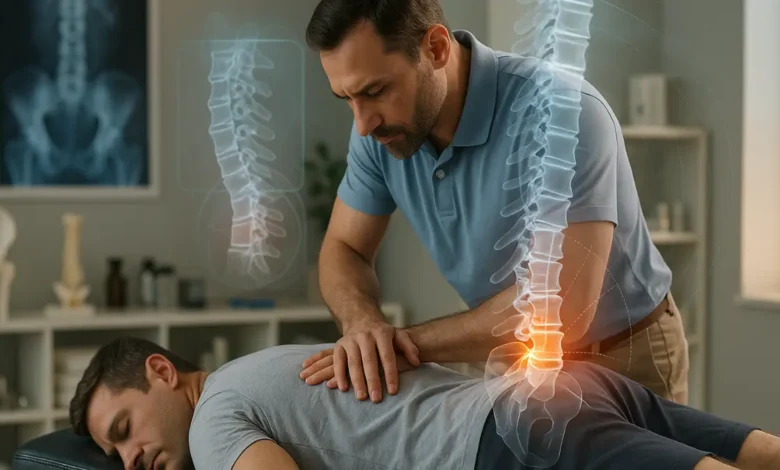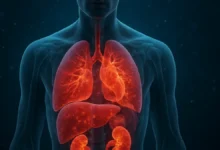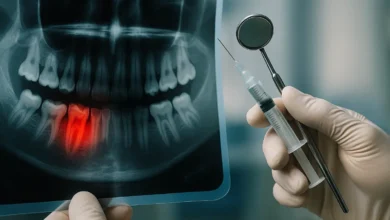Effective Herniated Disc Chiropractic Treatment Techniques for Lasting Pain Relief

Discover expert herniated disc chiropractic treatment techniques — from spinal decompression to gentle adjustments and muscle therapy — to relieve pain, restore balance, and promote natural healing effectively.
Introduction: The Power of Chiropractic Care for Herniated Discs
A herniated disc is one of the most common causes of back pain today, often described as a sharp, radiating discomfort that can travel from the spine to the limbs. When the soft, gel-like center of a spinal disc pushes through its tough exterior, it can press against surrounding nerves, creating pain, tingling, and weakness. While surgery is sometimes considered, many patients prefer natural, non-invasive methods — and that’s where chiropractic treatment comes in.
Chiropractic care focuses on realigning the spine, relieving nerve pressure, and restoring proper motion between vertebrae. Instead of masking symptoms with painkillers, chiropractors address the root cause — mechanical misalignment and disc stress. The goal is to help the body heal itself through precise adjustments, decompression therapy, and soft-tissue rehabilitation.
Whether your pain began after an injury, poor posture, or repetitive strain, chiropractic techniques can make a dramatic difference in mobility, comfort, and long-term spinal health.
Understanding a Herniated Disc
A herniated disc occurs when the outer layer of the disc (annulus fibrosus) tears, allowing the inner gel-like material (nucleus pulposus) to leak out. This bulging or ruptured material can irritate or compress spinal nerves, leading to pain that radiates down the arms or legs.
The lower back (lumbar spine) is the most common area affected, followed by the neck (cervical spine). Symptoms vary depending on where the herniation occurs — some patients experience sharp shooting pain, while others feel numbness or muscle weakness.
Unlike general back pain, a herniated disc directly involves nerve irritation. That’s why chiropractic care emphasizes restoring spinal motion and reducing nerve compression rather than merely treating muscular symptoms.
The Role of Chiropractors in Disc Healing
Chiropractors specialize in identifying misalignments or dysfunctions within the spine that contribute to disc stress. Through physical assessment, orthopedic testing, and sometimes imaging, they pinpoint the specific vertebrae involved.
Instead of “cracking bones,” as some might imagine, chiropractic adjustments use precise, controlled forces to restore alignment and relieve pressure. When done correctly, these techniques help reduce inflammation, restore circulation to the disc, and promote the body’s own repair mechanisms.
Chiropractors also teach patients posture correction, ergonomics, and home exercises — ensuring that recovery continues long after each session. The goal isn’t just short-term pain relief but sustainable spinal wellness.
Spinal Adjustments and Realignment Techniques
The foundation of herniated disc chiropractic treatment lies in spinal manipulation. These gentle adjustments target vertebrae that have moved slightly out of place, causing disc and nerve stress.
A chiropractor may use hands-on adjustments, drop tables, or specialized instruments to perform these corrections. Each adjustment is tailored to your spinal structure and comfort level. The technique improves mobility, reduces tension in surrounding muscles, and helps discs return to a more natural position.
Over time, consistent adjustments can improve spinal curvature, reduce nerve compression, and enhance overall balance in the musculoskeletal system. Patients often notice reduced pain, improved flexibility, and better posture after several sessions.
Expert Quote:
“A well-executed spinal adjustment isn’t about force — it’s about precision. The goal is to restore the spine’s natural motion and allow the body to heal from within.”
Flexion-Distraction Technique
The flexion-distraction technique is one of the most effective chiropractic methods for herniated discs. It uses a specialized adjusting table that gently stretches and flexes the spine in a rhythmic motion.
This process reduces pressure on the affected disc while improving the flow of nutrients and oxygen to the injured area. Because it’s non-thrusting and gentle, it’s ideal for patients who can’t tolerate traditional manual adjustments.
As the table moves, the chiropractor applies mild pressure to specific spinal segments, helping the disc retract away from the nerve root. Many patients describe it as relaxing, with noticeable relief even after the first few sessions.
Spinal Decompression Therapy
Spinal decompression is another cornerstone of herniated disc chiropractic treatment techniques. It involves using a computerized traction table that slowly and safely stretches the spine.
By creating negative pressure within the disc, decompression encourages the herniated material to retract, relieving nerve pressure and reducing inflammation. This also promotes fluid exchange — essential for disc healing since spinal discs lack a direct blood supply.
A standard decompression session lasts 15–30 minutes, during which patients feel a gentle stretching sensation rather than pain. Over time, it helps restore disc height, improve spinal stability, and alleviate chronic discomfort.
| Benefit | Result |
|---|---|
| Reduced Nerve Compression | Less pain and tingling |
| Improved Disc Hydration | Faster healing |
| Better Mobility | Enhanced posture and range of motion |
Pelvic Blocking and Gentle Positioning
For some patients, especially those with severe nerve impingement, chiropractors may use pelvic blocking. This involves placing cushioned wedges under the pelvis to adjust spinal angles and reduce disc pressure naturally.
This passive technique helps the herniated material move away from sensitive nerves without any thrusting or twisting. It’s often combined with gentle stretching and relaxation exercises, promoting spinal balance and reducing lower back tension.
Pelvic blocking is subtle but powerful — it encourages natural disc movement and can relieve sciatic-type pain over time.
Soft-Tissue Therapy and Myofascial Release
A herniated disc doesn’t just affect bones — it strains surrounding muscles, ligaments, and fascia. Chiropractors often combine spinal adjustments with soft-tissue therapies to address these components.
Myofascial release, trigger-point therapy, and deep tissue massage help relax tight muscles, reduce spasms, and improve circulation around the injured disc. When the surrounding tissues loosen, spinal alignment becomes easier to maintain, and healing accelerates.
This integrated approach not only relieves pain but also enhances long-term spinal function. Chiropractors often teach patients simple self-massage or stretching techniques to continue this process at home.
Lifestyle, Ergonomics, and Postural Coaching
One of the most overlooked aspects of herniated disc chiropractic treatment is posture and lifestyle. Poor sitting habits, weak core muscles, or repetitive strain from daily activities can continually aggravate disc problems.
Chiropractors educate patients about workstation ergonomics, correct lifting techniques, and sleeping positions that protect the spine. Strengthening the abdominal and back muscles is also encouraged to stabilize the core and prevent future disc issues.
A combination of chiropractic care, exercise, and mindful posture correction creates a powerful defense against re-injury.
Rehabilitative Exercises for Disc Recovery
Chiropractors often prescribe personalized exercise programs designed to strengthen supportive muscles and improve flexibility. Gentle stretching, core activation, and controlled movement are key components.
Common exercises include cat-camel stretches, pelvic tilts, bird dogs, and McKenzie extensions — all designed to decompress the spine and improve circulation. These movements help maintain spinal alignment and prevent stiffness between sessions.
Consistent home practice reinforces chiropractic adjustments and ensures that healing continues daily, not just during office visits.
Comparing Chiropractic Care with Other Treatments
While medications can dull the pain and surgery can remove disc fragments, chiropractic care stands out for addressing the root mechanical dysfunction without invasive measures.
| Treatment Type | Approach | Focus |
|---|---|---|
| Chiropractic Care | Natural, alignment-based | Restore motion and nerve health |
| Physical Therapy | Muscle strengthening | Function and flexibility |
| Surgery | Invasive correction | Remove or fuse disc material |
| Medications | Symptom relief | Temporary pain control |
Chiropractic care is often used alongside physical therapy or medical supervision for best results, ensuring a holistic approach that prioritizes the patient’s comfort and long-term wellness.
Benefits of Chiropractic Treatment for Herniated Discs
Chiropractic care offers numerous benefits beyond pain relief. The adjustments and decompression techniques help restore natural spinal alignment and improve disc health.
Patients often report:
- Reduced inflammation and swelling
- Better nerve communication and muscle strength
- Enhanced flexibility and posture
- Decreased reliance on pain medication
- Improved sleep and energy levels
Unlike temporary relief methods, chiropractic care aims to restore the body’s functional integrity. Over time, this leads to sustained comfort and resilience against future injuries.
Potential Risks and Considerations
While chiropractic care is generally safe when performed by a licensed professional, it’s not suitable for everyone. Severe disc ruptures, spinal instability, or certain medical conditions may require medical clearance before starting.
Patients should always share their full medical history and imaging results with their chiropractor. A responsible practitioner will adapt treatment intensity or refer to another specialist if necessary.
Mild soreness after adjustments is normal, but pain or discomfort that worsens should always be reported immediately.
Patient Success Stories and Real-World Insights
Many patients who once struggled with daily pain now lead active, pain-free lives after consistent chiropractic care. Whether it’s returning to work, exercising again, or simply sitting comfortably — the improvements can be life-changing.
Patient Testimonial:
“I was nervous about seeing a chiropractor for my herniated disc, but within a few weeks of decompression and gentle adjustments, the pain that had haunted me for months was gone. I finally felt like myself again.”
Hearing these stories reinforces that non-surgical, hands-on care can truly make a difference — when paired with patience and lifestyle commitment.
FAQs about Herniated Disc Chiropractic Treatment
What is the best chiropractic technique for a herniated disc?
The flexion-distraction and spinal decompression techniques are the most effective for relieving pressure and promoting healing without aggressive manipulation.
Can chiropractic care fully heal a herniated disc?
While chiropractic treatment can’t “heal” a torn disc structure completely, it can reduce inflammation, improve motion, and relieve symptoms long-term by supporting the body’s healing processes.
How long does it take to see results?
Some patients feel relief after one or two sessions, while chronic cases may require several weeks. Consistency and following home care instructions are key to success.
Is chiropractic treatment safe for all ages?
Yes, chiropractors adjust techniques for each patient’s age and condition — from gentle mobilization for seniors to active rehab for younger adults.
Should I stop exercising with a herniated disc?
You don’t have to stop completely, but you should modify your activities. Chiropractors can guide you toward safe movements that support healing rather than aggravate it.
Conclusion
Herniated disc chiropractic treatment techniques offer a powerful, natural alternative to invasive surgery or dependency on medication. Through gentle spinal adjustments, decompression therapy, and soft-tissue rehabilitation, chiropractors restore alignment and reduce nerve pressure — helping patients regain comfort, function, and freedom.





